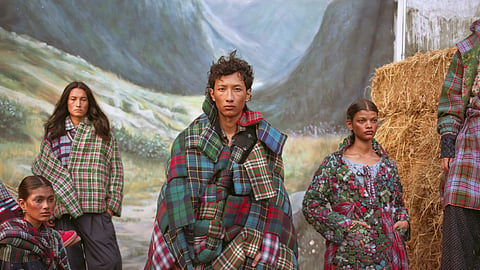
- HOMEGROWN WORLD
- #HGCREATORS
- #HGEXPLORE
- #HGVOICES
- #HGSHOP
- CAREERS
- ABOUT US
- CONTACT US

péro’s Fall-Winter 2025 collection, ‘BONNIE’, reimagines traditional Scottish tartan through India’s diverse handloom heritage. Designer Aneeth Arora draws parallels between the Highlands and India’s artisan regions, where textiles are deeply tied to ancestry, community, and resistance. Using Maheshwari, Chanderi, Varanasi brocades, Kullu wool, Pashmina, Mashru, and Bengal cotton, the brand reconstructs tartan’s iconic geometry into fabrics that speak with many regional accents.
In the global landscape of luxury fashion, tartan is instantly recognisable: its crisscrossing lines carry centuries of clan identities and Scottish highlands history. But this year, the iconic textile steps into a new geography. Homegrown fashion label péro, founded by designer Aneeth Arora in 2009, introduces ‘BONNIE’ — a Fall-Winter collection that redraws tartan’s map across the subcontinent’s weaving clusters, linking two cultures where textiles are more than adornment; they are embodiments of ancestral traditions, community identity, and a sense of belonging.
péro has long championed slow, handcrafted processes, and this collection extends that mission. The Scottish Highlands serve as a conceptual complement to India’s own highlands, river belts, and artisanal heartlands. The parallels are evident: both regions developed pattern-rich textiles as identity systems long before they became global fashion hotspots.
The Tartan, traditionally rugged and timeless, transforms through Péro’s signature surface ornamentation, including beadwork, stumpwork, appliqué, quilting, ruffles, and pleats. A highlight of this collection is the incorporation of semi-precious, uncut, and polished stones, which appear in embroidery and tassels, evoking the essence of moorland rain and woodsmoke. The collection offers oversized coats and jackets, androgynous tops, shirts, dresses, wide-pleated trousers, pullovers, and cardigans, all accented with scarves, caps, and mufflers.
Tartan, with its crisscrossing checks and clan identities, is more than just a pattern. It carries memory, resistance, and a sense of belonging. péro treats this textile history with respect while loosening its rigidity, allowing it to travel and transform. Instead of simply replicating tartan as it is, péro has reconstructed its geometry using Indian crafts: Maheshwari cotton-silk and Chanderi for lightness and sheen; Varanasi silks and brocades for depth; warm wool from Kullu and Pashmina from Kashmir for highland comfort; Mashru from Gujarat for its unique silk-cotton blend; and Bengal cotton for everyday comfort. The result is a lattice of geography and tradition — one textile speaking with many accents.
Tartan was once banned across the British Empire under the Dress Act of 1746, which considered the textile a symbol of Highland rebellion. The ban prohibited Highland dress, including kilts and plaids, but explicitly restricted the use of tartan in upper coats. During the Freedom Movement, Indian textiles also became political tools under British colonial rule, from khadi to Bengal weaves suppressed by Manchester mills. In both regions, these textiles resisted erasure and became integral to indigenous identity.
The collection draws on this shared history. Tartan’s greens, blues, and reds represent the topography and kinship of the Scottish Highlands. In India, Maheshwari and Chanderi signify royal heritage, Kashmiri Pashmina reflects mountain craftsmanship, and Bengal cotton embodies everyday craftwork. When these materials adopt tartan patterns, the outcome is not just a blend for novelty but an acknowledgement that these threads hold identities and histories. péro suggests that identity, like tartan, is a pattern constantly woven and rewoven. What was once rugged Highland garb now moves freely through Indian looms, accumulating new stories without losing its own.
Follow péro here.
If you enjoyed reading this, here’s more from Homegrown:
Niharika Vivek Channels Indian Princess Energy Into Upcycled Corsets, Column Dresses, & More
QUOD’s New Collection Personifies Their Founders Ikshit Pande's Slow Algorithm Rebellion
Raw Mango's New Festival Collection Is A Surreal Blend Of Culture, Craft, & Creativity
